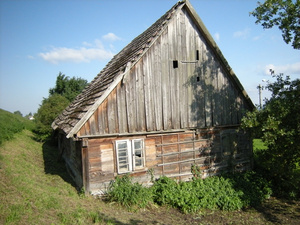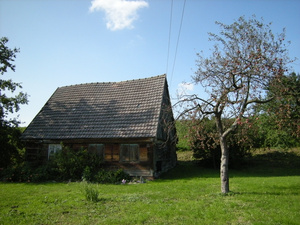|
gm. Sadlinki, pow. kwidzyński, woj. pomorskie
(Do 1945 roku Gross Nebrau)

In 1250, the village land became part of the Pomezanian bishop's property. The name mentioned at the end of the 13th century - Niewierz, Neber, perhaps as a property of the lords of Nawra under the Magdeburg law. In 1303, Jan z Nebrowa-Johannes de Ebere was mentioned. On the 5th of February 1396, the bishop of Pomezania, Jan, grants 67 ha of meadows to Nebrowo village under the Chełm Law. In 1373, Jan was the village leader in Nebrowo, and in 1393, Mikołaj was the church rector. In 1421, ice jams caused a break of protective floodbanks on the Vistula. In 1435, the Teutonic Knights' army stayed in the village in order to defend the river crossing near Nowe in case of an attack by Hussites who invaded Pomerania. Floods in the period of 1480-1501 and the war between Poland and the Teutonic Knights in the years 1519-1521 destroyed the village. In 1547, the village got a privilege on 722 ha of land, with an obligation to repair the floodbanks. A village leadership covering 50.4 ha of land is granted for 90 grzywnas (=720 pfennings) to Szymon Kusch, under the Chełm Law. The oldest church was demolished in 1570. In 1580, 21 Mennonites got a settlement contract on 756 ha of land. In 1590, a new church was built (the old one burnt in 1624). In 1624, the settlement Małe Nebrowo was separated. The present church was built in 1749. The farmers got the land for perpetual usufruct in 1788. In that year, there were 23 farms. The village belonged to the Catholic parish in Nowe, while it had a locally situated school and an evangelical parish. At the end of the 19th century, the village counted 2,429 acres of land with 73 buildings, 27 houses, 262 inhabitants, 39 Catholics, 221 evangelicals. In the years 1918-1939, it was a borderline village with a military police border post. It had a steam mill, a sawmill owned by Adolf Schmidt, a blacksmith's shop, an inn with a garden and a dancing room and numerous shops. A village arranged in rows, situated on the right bank of the Vistula, in the southern part of the Kwidzyn lowlands, about 20 km south of Kwidzyn. The cultural landscape has been preserved in a very good condition. The original layout of settlements and fields is clearly visible.
The village relics include the church of Mother of God, the Queen of Poland, built in 1749, the chapel dedicated to Saint Wojciech, built in 1928, as well as wooden homesteads Nos. 24 and 27 dated back to the middle of the 19th century.





SGKP, t. 6, s. 944; R. Flans, Das ehemalige Amt Marienwerder, insonderheit die Amts-Niederung, „Zeitschrift des Historischen Vereins für Reg.-Bez. Marienwerder“ H. 35, 1897, ss. 7, 26-49; M. Kerner-Żuralska, Materiały do dziejów osadnictwa Pomezanii [w:] „Komunikaty Mazursko-Warmińskie”, nr 2, 1964, s. 163; E. Wernicke, Kreis Marienwerder. Aus der Geschichte des Landkreises bis zum 19. Jahrhundert, Hamburg 1979, s. 133-158; A. Lemański, W. Odyniec, J. Powierski, Dzieje wsi [w:] Kwidzyn. Z dziejów miasta i okolic, Olsztyn 1982, s. 270-272.
Strony internetowe: http://kwidzynopedia.pl/index.php/Nebrowo_Wielkie, 04.08.2009.
|





